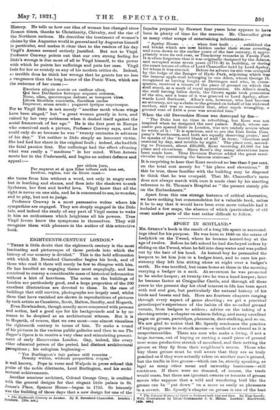EIGHTEENTH-CENTURY LONDON.*
" THEBB is little doubt that the eighteenth century is the most fascinating and picturesque of those periods into which the history of our country is divided." This is the bold affirmation with which Mr. Beresford Chancellor begins his book, and of those who read it there will surely be few to disagree with him. He has handled an engaging theme most engagingly, and has contrived to convey a considerable mass of historical information without a hint of heaviness. The notes on the buildings of London are particularly good, and a large proportion of the 200 excellent illustrations are devoted to these. In the case of buildings that still survive, photographs are largely used, whilst those that have vanished are shown in reproductions of pictures by such artists as Canaletto, Scott, Mahon, Sandby, and Hogarth.
Even Rowlandson, though usually more concerned with persons and action, had a good eye for his backgrounds and is by no means to be despised as an architectural witness. But it is to Hogarth, of course, that we owe most—one almost visualizes the eighteenth century in terms of him. To make a round of his pictures in the various public galleries and then to see The Beggar's Opera is to receive a very clear and stimulating present- ment of early Hanoverian London. Gay, indeed, like every ether educated person of the period, had distinct architectural perceptions ; his eulogium beginning-
" Yet Burlington's fair palace still remains
Beauty within, without proportion reigns," IS well known. Pope in verse and Walpole in prose echoed this praise of the noble dilettante, Lord Burlington, and his archi- tectural achievements.
Another amateur architect, Colonel George Grey, is credited with the general designs for that elegant little palace in St. James's Place, Spencer House—begun in 1755. So leisurely was the building of those days that a new design for one of the • The Eighteenth Century in London. By E. Bamford Chancellor. Loudon :
BataiorcL net.)
facades prepared by Stewart four years later appears to have been in plenty of time for the masons. Mr. Chancellor gives us many other scrape of entertaining information t- " Apeley House . . . when first built . . . exhibited the red bricks which are now hidden under their stone covering, and even down to the earlier years of the last century, it appro- priately wore its red coat, as Thackerad remarks in Vanity Fair.It is often forgotten that it was on y designed by the Adams, and occupied some seven years ( 771-8) in building, or during the exact tenure of office of Lord Chancellor held by Lord Apsley, for whom it was erected. Before its advent its site was occupied by the lodge of the Ranger of Hyde Park, adjoining which was the famous apple-stall belonging to one Allen, whom George IL recognised as having fought at Dettingen and who, in conse- quence, received a tenure of the piece of ground on which the stall stood, as a mark of royal appreciation. On Allen's death, the stall having fallen down, the Crown again took possession of the site, and a lease of it was granted to Lord Apsley, after- wards Lord Bathurst. Allen's son, however, who had become an attorney, set up a claim to the ground on behalf of his widowed mother, and was so successful that, after much wrangling, a ground rent of £450 a year was awarded him."
When the old Devonshire House was destroyed by fire- " The Duke lost no time in rebuilding, but Kent was not inspired when he designed the new palace. Ralph, whose sar- castic pen spared little in London, was not unduly severe when he wrote of it : ` It is spacious, and so are the East India Com- pany's Warehouses, and both are equally deserving praise,' and he speaks of the ' horrid blank of wall ' in front, ' cheerless and unsocial by day, and terrible by night.' The place cost, accord- ing to Pennant, about £20,000, Kent receiving £1,000 for his plans and elevations. Since Kent's day many alterations have been made here. Thus Decimus Burton added the great semi- circular bay containing the famous staircase."
It is surprising to hear that Kent received no less than 5 per cent. on the total cost merely for " his plans and elevations." If this be true, those familiar with the building may be disposed to think that he was overpaid. That Mr. Chancellor's taste does not always match with ours is made clear by his startling reference to St. Thomas's Hospital as " the present stately pile on the Embankment."
Apart from this one strange instance of critical aberration, we have nothing but commendation for a valuable book, unless it be to say that it would have been even more valuable had it included a few maps, the absence of which (particularly of old ones) makes parts of the text rather difficult to follow.


































 Previous page
Previous page